Type species: Sphingonaepiopsis gracilipes Wallengren, 1858.
A genus containing seven species and occurring in the southern Palaearctic, Oriental and Afrotropical regions (Kitching & Cadiou, 2000).
IMAGO: Distal margin of forewing dentate or lobate. Labial palpus rough-scaled, first segment with lateral apical fan. Eye lashes and a high head-tuft present. Spines of abdomen very weak. Antenna dentate or pectinate in male, simple and club-shaped in female; terminal segment short. Tibia spinose; midtarsus with a basal comb; hindtarsus with a few basal spines. Hindtibia with two spurs of equal length. Paronychium with lateral lobes very small, the ventral ones absent; tarsi long. Veins M3 and Cu1 of forewing originating close together; Cu2 at apical third of cell. Costal margin of hindwing almost straight, convex near base; Cu1 and Cu2 close together, some distance from angle of cell.
Genitalia. In male, uncus elongate-triangular, apex more or less rounded-truncate; gnathos either strongly chitinized, with the upperside transversely ribbed distally, or short, broad, membranous. Valva without friction scales; sacculus variable; phallus with or without apical processes. In female, lamella postvaginalis triangular, apical edge projecting.
OVUM: Small, spherical, green.
LARVA: Typically sphingiform, with a noticeably thin body and small horn, and pale, longitudinal stripes. Head large; thorax weakly constricted anteriorly.
PUPA: Proboscis fused with body. Small, very glossy; similar in shape to that of Hyles spp. but boldly marked with black, or nearly all black. Cremaster dorso-ventrally flattened, broadly triangular, with a rounded or bifurcated tip.
HOSTPLANT FAMILY: Herbaceous plants of the Rubiaceae.
UK: Gorgon Hawkmoth, F: Sphinx Gorgon; Sphinx pygmée, D: Chalcedongrauer Schwärmer; Chalcedongrauer Gorgonschwärmer, RUS: Karlikovyi Brazhnik, FIN: Kääpiökiitäjä, HR: gorgonin ljiljak.
Proserpinus gorgoniades Hübner, [1819], Verz. bekannter Schmett.: 132.Type locality: Lower Volga, Russia.
(Taxonomic notes. (i) The various but not very clearly defined forms of Sphingonaepiopsis gorgoniades appear to have developed in several isolated refugia during the last (Pleistocene) ice-age. They have since re-established contact to some extent and appear to be merging in a manner similar to that of Deilephila porcellus (Linnaeus, 1758) and its forms.
(ii) Mentzer (1974) described 'subsp.' chloroptera as a subspecies of Sphingonaepiopsis pfeifferi, having separated the latter from Sphingonaepiopsis gorgoniades on minor morphological grounds. This was not warranted. 'Subsp.' chloroptera is here regarded as a form synonymous with Sphingonaepiopsis gorgoniades, as per the opinions of Kitching & Cadiou (2000). Supporting this view, some individuals of subsp. gorgoniades from the Crimea are indistinguishable from form chloroptera. The early stages of all three races are identical.
(iii) In fact, all described subspecies of Sphingonaepiopsis gorgoniades are untenable as they appear to be environmentally induced forms. In wetter areas individuals tend to be larger, darker and better marked, i.e. form chloroptera. In drier, more desertic areas populations tend to become smaller, paler and less well marked, i.e. form pfeifferi. The latter is thus relegated from a subspecies to a form.)
[Further details on this species, as well as photos of all stages, can be found on Lepiforum.]
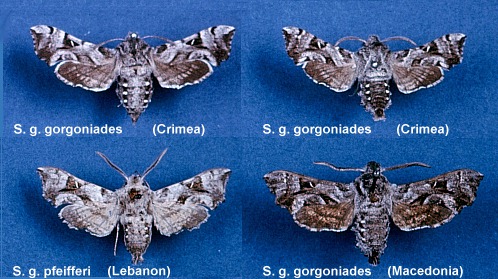
Holarctic; Palaearctic (both eastern and western subregions). Pleistocene refuge: Polycentric -- Pontomediterranean subsection of the Mediterranean refuge and probably the Caspian, Iranian, Turkestan, Mongolian and Manchurian refugia, and several adjacent eremic refugia, such as the Syrian refuge, and Afghan subsection of the Turkestan refuge.
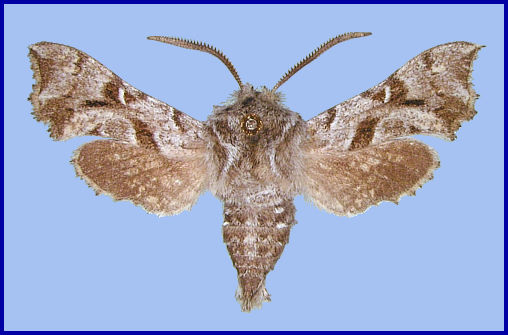
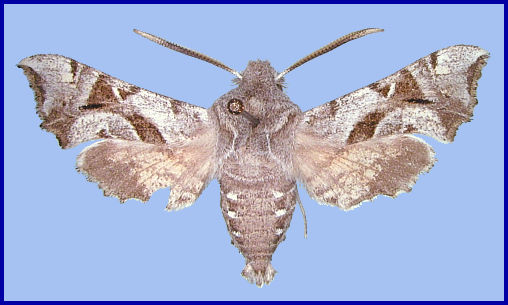
Wingspan: 25--32mm. Cannot be confused with any other hawkmoth from the region, except Sphingonaepiopsis kuldjaensis (Graeser, 1892) and Sphingonaepiopsis asiatica (Melichar & Řezáč, 2013). Forewing whitish grey. Exhibits very little variation except in intensity of coloration and extent of buff or pale orange speckling on the hindwings. In some individuals the hindwings may be heavily marked with pale orange spots. In drier locations, this speckling occurs on the forewing of some paler, brownish individuals.
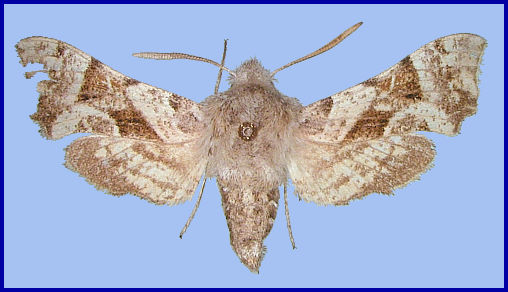
Form pfeifferi can be distinguished by its much lighter, brownish forewings and very extensive buff or orange speckling on both the fore- and hindwing.
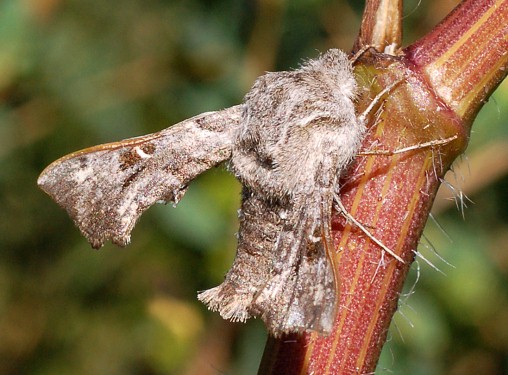
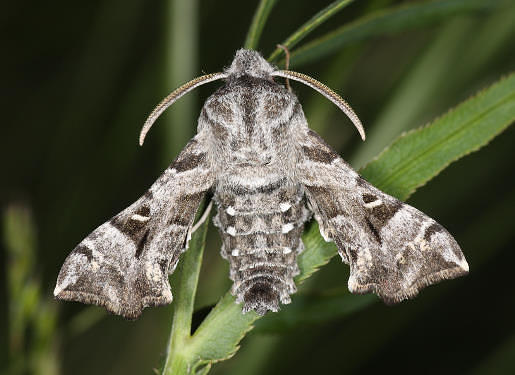
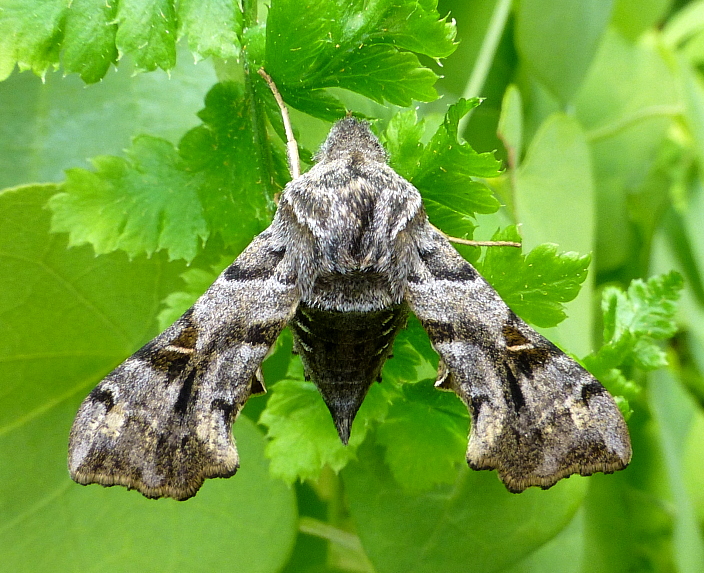
Crepuscular, occurring in open scrub and hilly steppe in small, local but dense colonies which are easily overlooked due to its small size. Generally at 2000--2500m in the Caucasus. Recorded from Iran (Lorestan Province) from 2400m altitude, but in Lebanon it is normally found at around 1700m. In Jordan it prefers old sparse oak forests at 500-1000m with a good undergrowth of herbaceous plants (Müller et al., 2005a). Little is known of its behaviour, though it is strongly attracted to flowers at dusk. In the chalk hills of the Saratov/Volgograd area, southern Russia, up to two or three moths can be seen at any one time visiting flowers of low-growing Fabaceae (A. Zagorinsky, pers. comm. 2012).
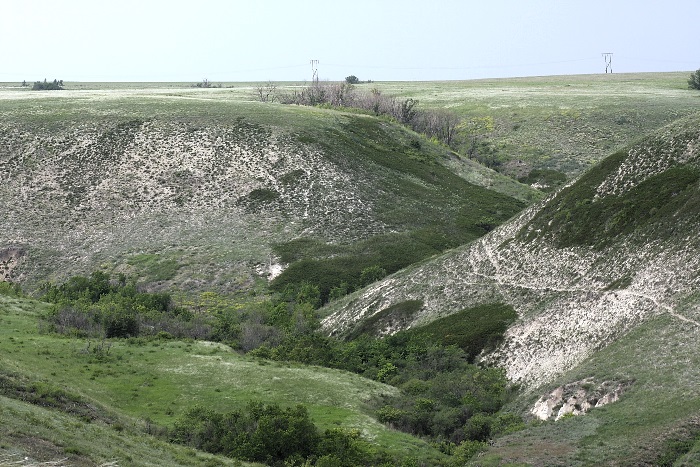
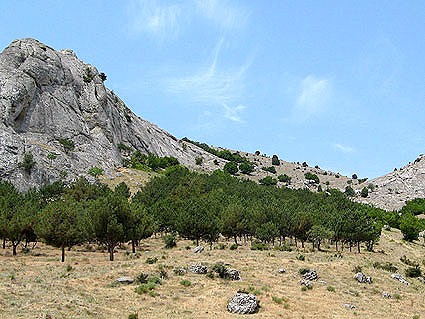
Bivoltine; mainly late May and early June, with a second brood in late July/August. In the southern Urals, from late May until mid July, with a partial second generation in late July--early August (Nupponen & Fibiger, 2002).
Some early and late individuals have been reported in its southern range, in April and September/October. A single Romanian specimen was captured in early May, 2005 (Mihut & Dinca, 2006).
OVUM: Small (1.0--1.1mm), spherical, pale green, becoming deep yellow just before hatching (Danner, Eitschberger & Surholt, 1998).
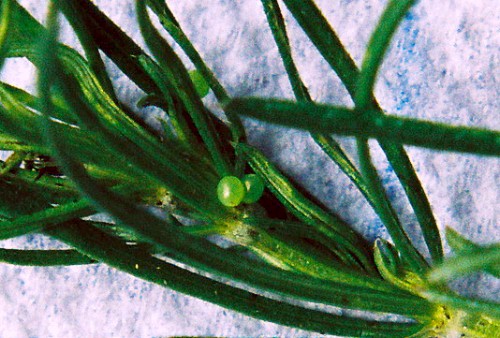
LARVA: Full-fed, 30--40mm. Polymorphic: glaucous-green, reddish or whitish; all with longitudinal white stripes.
Early instars described and illustrated in full by Danner, Eitschberger & Surholt (1998). Newly emerged 2.5mm, dull yellow, with a very large head. With feeding body becoming glaucous-green with many fine white spots, thus giving the appearance of being grey. A pale dorso-lateral line runs from the pale orange head to the small, black, upturned horn. Each body segment is encircled by a row of black setae and the entire larva is covered with fine white hairs.
In the second instar the final body colour and patterning sets in (see below), with the larva losing it's black setae and becoming pilose.
In fully-grown larvae, the cylindrical body may be glaucous-green, reddish or whitish, with longitudinal white stripes which continue over the head. There are two narrow dorsal stripes, a thicker and bolder dorso-lateral one and an equally bold sub-spiracular one, all of which may sometimes be bordered with red. The head is rounded, with short bristles; horn pink or orange, narrow, short, straight or slightly curved upwards, often with a black tip; spiracles white, set below an additional, very faint, lateral stripe.
Active mainly at night, with many larvae being present over a small area. Flowers are consumed in preference to leaves. The larvae are very sensitive and will drop from the plant at the slightest disturbance.
Occurs mainly in June, July and September.
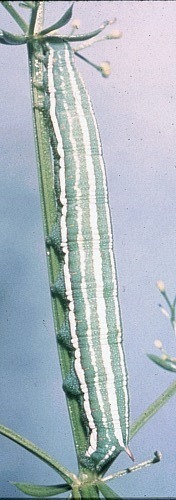
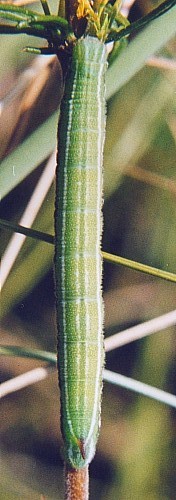
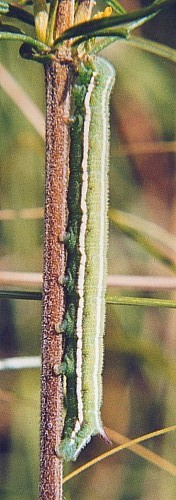
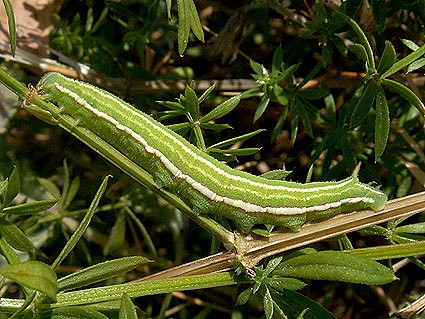
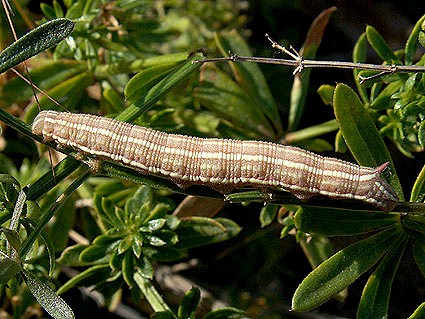
Major Hostplants. Galium, particularly Galium verum (Danner, Eitschberger & Surholt, 1998).
Minor Hostplants. Other species of Rubiaceae.
PUPA: 18--20mm. Shiny blackish-brown with orange-brown intersegmental cuticle on the abdomen. The surface of the head and thorax are slightly wrinkled and the abdomen is heavily punctate. The proboscis projects weakly frontad. Cremaster elongate, triangular, dorso-ventrally flattened with a bifurcated tip. Formed in a loosely-spun cocoon of silk among debris on the ground. The overwintering stage.
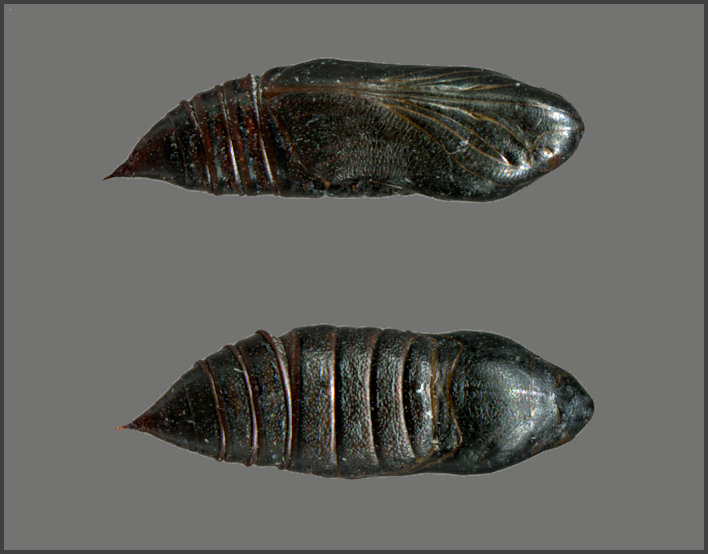
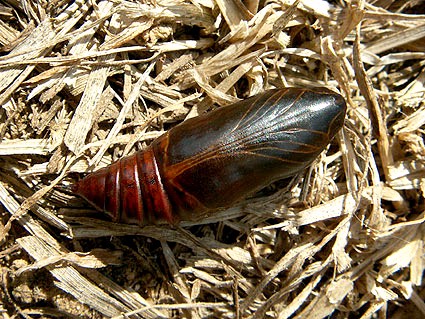
None recorded.
From Croatia (??Klis, Solin, near Split, larva 13 September 2022 (Anton Gjeldum, iNaturalist 2022)) and (near Senj (Abafi-Aigner, 1910)) (series in NHMUK coll. and one male in the Vienna Natural History Museum (Zerny, 1933)), Albania (Beshkov, Nahirnić-Beshkova & Jakšić, 2024), the Republic of North Macedonia (Mentzer, 1974; Krpač et al., 2019), central and southern Greece (de Freina & Piatkowski, 1999; Schulze & Weigert, 2006), eastern Bulgaria (Beshkov, 1990; Beshkov, 1995) and Romania (König, 2003; Mihut & Dinca, 2006; SzÚkely, 2016) across the southern Ukraine and Crimea (Zerny, 1933; Efetov & Budashkin, 1990), southern Russia (Meigen, 1830; Poltavsky & Artohin, 2000) as far north as Kazan (probably now extinct in this area), the southern Urals (Nupponen & Fibiger, 2002) and eastern Kazakhstan (Eversmann, 1844)) to Kyrgyzstan (Kitching & Zahiri, 2007) and Afghanistan (Ebert, 1969; Daniel, 1971).
Also, from central, southern and eastern Turkey (Lederer, 1855; Daniel, 1932; Daniel, 1939; Hariri, 1971; Akin, 2012; Kemal & Košak, 2014; Kemal & Košak, 2016; Kemal & Košak, 2017; Košak & Kemal, 2018; Kemal, Košak & Ušak, 2018), Lebanon (Zerny, 1933; Ellison & Wiltshire, 1939), Israel (Müller et al., 2005b) and western Jordan (Müller et al., 2005a) eastward across northern Iraq (Wiltshire, 1957; Kemal & Košak, 2018c), the Caucasus (Armenia, Republic of Georgia and Azerbaijan (Derzhavets, 1984; Didmanidze, Petrov & Zolotuhin, 2013; Snegovaya & Petrov, 2021)), Daghestan, Russia (Ilyina & Poltavsky, 2018; Yakovlev et al., 2022), northern Iran (Kitching & Zahiri, 2007; Lehmann & Zahiri, 2011) to southern Turkmenistan (Danov & Pereladov, 1985; Danner, Eitschberger & Surholt, 1998; Dubatolov, [1999]).
In the Kopet-Dagh Mountains separating Iran and Turkmenistan it appears to be replaced by the near identical Sphingonaepiopsis asiatica Melichar & Řezáč, 2013. Some of the northern Iranian and Turkestan individuals mentioned above may be of this species.
A very disjunct and, as yet, poorly understood distribution. May occur in a great many areas other than those indicated, being easily overlooked because of its small size and crepuscular behaviour of the adult. There are old as well as recent unconfirmed reports that this subspecies may occur in Hungary (Rougeot & Viette, 1978); however, these may refer to the Croatian population (Croatia was formally part of the old Kingdom of Hungary).
Extra-limital range. Although reported as occurring across southern Siberia to the Altai Mountains (Pittaway, 1993), and possibly Amurland (Russia), this is erroneous. This information was based, at least in part, on two females labelled 'Amur' in th NHMUK that were part of the Crowley bequest. However, an annotation by Crowley in the Accession Register of 1901 states -- "note specimens labelled 'Amur' are from Turkestan (probably Neu Margelan)". This corresponds to Farghona [= Fargana] in present-day Uzbekistan (Kitching & Zahiri, 2007).
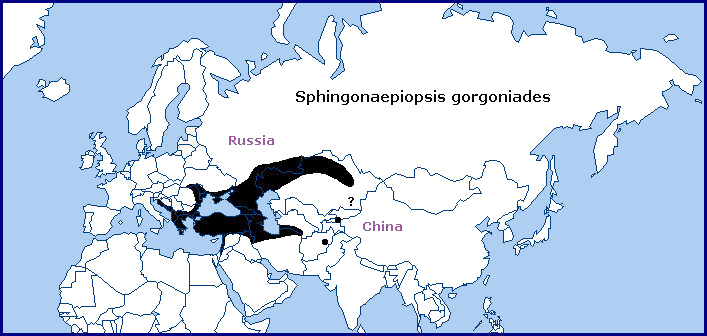
 Return to species list
Return to species list